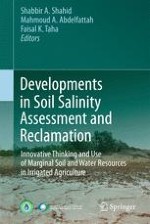2013 | OriginalPaper | Buchkapitel
10. Mapping the Risk of Soil Salinization Using Electromagnetic Induction and Non-parametric Geostatistics
verfasst von : Houria Dakak, Aicha Benmohammadi, Brahim Soudi, Ahmed Douaik, Mohamed Badraoui, Abdelmjid Zouahri
Erschienen in: Developments in Soil Salinity Assessment and Reclamation
Verlag: Springer Netherlands
Aktivieren Sie unsere intelligente Suche, um passende Fachinhalte oder Patente zu finden.
Wählen Sie Textabschnitte aus um mit Künstlicher Intelligenz passenden Patente zu finden. powered by
Markieren Sie Textabschnitte, um KI-gestützt weitere passende Inhalte zu finden. powered by
